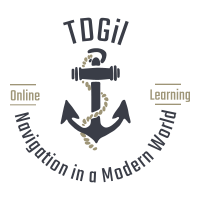Tradewinds Sailing School and Club
Bareboat Charter Instructor Manual
Included in this module are the daily agendas, equipment requirements, and basic ASA standards. At the end of each module you will be advanced to the next module for additional detail on each topic in the daily agendas.
Bareboat Charter (BBC – ASA 104)
Prerequisites for the Class
- Basic Keelboat – ASA 101
- Basic Coastal Cruising – ASA 103
- Completion of the Basic Coastal Cruising practice exercises
Schedule & Crew
This is a three-day course. Day one is 9am to 5pm. Class will begin on day two at 9am and continue until 5pm on day three with an overnight at anchor at a location on the bay chosen by the instructor. There will be a minimum of two and a maximum of three students and one instructor aboard.
Description
Learn additional requirements for coastal cruising of auxiliary sailing yachts during daylight hours and earn Bareboat Chartering Certification. Subjects include cruise planning, living aboard, basic weather forecasting, Rules of the Road, boating etiquette, safety equipment, chart reading and use, extensive practice of on board skills, and much more.
Students successfully completing this course can receive ASA 104 certification and will have the skills necessary to independently coastal cruise boats in our Silver Fleet. You will live aboard during the course.
What Boats Are Used
In this class, you will instruct students using two Silver and/or Gold Fleet boats.
ASA Standard
Demonstrated ability to skipper a sloop-rigged, auxiliary powered keelboat (or catamaran, if course is conducted on such) of approximately 30 to 45 feet in length during a multi-day cruise upon inland or coastal waters in moderate to heavy winds (up to 30 knots) and sea conditions. Course is conducted as a live-aboard cruise of at least 48 hours. Knowledge of provisioning, galley operations, boat systems, auxiliary engine operation, routine maintenance procedures, advanced sail trim, coastal navigation including basic chart plotting and GPS operation, multiple-anchor mooring, docking, health & safety, emergency operations, weather interpretation, and dinghy/tender operation.
Day One Agenda
Introductions
Boat Systems & Boat Familiarization
Boat Handling
- Discussion of Forces Influencing Boat Handling (Wind, Current, Prop Walk, Prop Wash, Momentum, Inertia)
- L.O.T.
- Slip Departure & Return
- Forward/Reverse Handling
- Fairway turns
- Under Power Crew Overboard
Docking & Motoring
- Windward side docking
- Departures using “aft facing bow spring” and “forward facing stern spring”
- Leeward side docking using midships spring “stopping” line
- Backing into side tie (pump out station)
Lunch
Anchoring
- Bow & Stern (discussion of Bahamian Moor)
- Two off the bow (Forked)
- Mediterranean Moor (if time allows)
- Discuss provisioning needs for overnight
Navigation Aids
- Local Notice to Mariners
- Light List
- Coast Pilot
Charts & Plotting
- Finding Latitude and Longitude on a Chart
- Plotting and labeling a course
- Distance/Speed/Time calculations (D St wheel)
- TVMDC +W
- Keeping a navigator’s log
- Plotting & Maintaining a DR
- Obtaining a fix
- Plot a course to either Clipper Cove or Pier 1½ as tides for day 2 allow
- Provide only destination lat/long, desired time of arrival and estimated speed. Students complete plot and calculate departure time
Day Two Agenda
Meet on Boat
Boat Systems & Boat Familiarization
Provision and Stow for overnight
Verify water tanks are full
Tides & Currents
Advanced use of a tide book
- Determine sunset and sunrise times
- Tidal Differences
- Current Differences
- Use of Tidal Current Charts to estimate current in different locations mid tidal range
- Tidal “Rule of Twelfths” to estimate tidal depths mid tidal range
Depths and Depth sounders
- Sound the depth at the slip using a sounding line and compare to electronic depth sounder on boat
Boat Handling
- L.O.T.
- Slip Departure & Return
- Forward/Reverse Handling
- Fairway turns
VHF Radio usage and Vessel Traffic Services monitoring
Departure from Marina Bay – Sail itinerary to be chosen by instructor. It is recommended to do a “tour” of several locations on the bay. Maintain a DR obtaining fixes and continuing DR
Lunch Underway
Heavy Weather Sailing (conduct in “the slot”)
- Reefing
- Heaving To
- Broad Reach to Close Reach COB
- Goal is to reach The Golden Gate Bridge under sail
Anchor set at 17:00 to 1800
Dinner
Test Review
Day Three Agenda
Breakfast
Wind & Current docking at Ayala Cove if able
Lunch ( While underway)
Heavy Weather Sailing
- Reefing
- Heaving To
- Quick Stop COB
Return Sail to Tradewinds with arrival between 1500 & 1600
Pump out holding tank
Clean up boat
Test
The test may be taken at any convenient time during day 2 or 3. For example at anchor after dinner or after breakfast.
Recommended Class Sailing Areas
Each day’s sailing location is up to the discretion of the individual instructor; however, all allowable areas of the “practice area” should be explored. One recommend schedule of locations is as follows:
- Day 1 – Marina Bay
- Day 2 and Day 3 – San Francisco, “The Slot” Angel Island, Richardson Bay, Paradise Cove
Required Class Equipment
The following documents and/or equipment should be on board.
For all classes
- Type I PFD for each person on board
- USCG Commercial approved ring buoy
- Updated chart of the area (18649)
- Coast Pilot and Updated Light List
- Current Local Notice to Mariners
- Drug Test Kit
- Safety Briefing Outline
- Dock lines (4 as required by the boat)
Additional Equipment for Basic Coastal Cruising
- Hand held compass
- Practice chart of the area (18649)
- Parallel Rule and Dividers
- Overnight cooking kit
